A Checkride for the Sewanee Flying Tigers
One of the only liberal arts colleges in the country with an airport on campus, Sewanee is offering a revitalized flight program with the hope that students will be drawn to getting a bird’s-eye view of the Domain and earning a pilot’s license in the process.
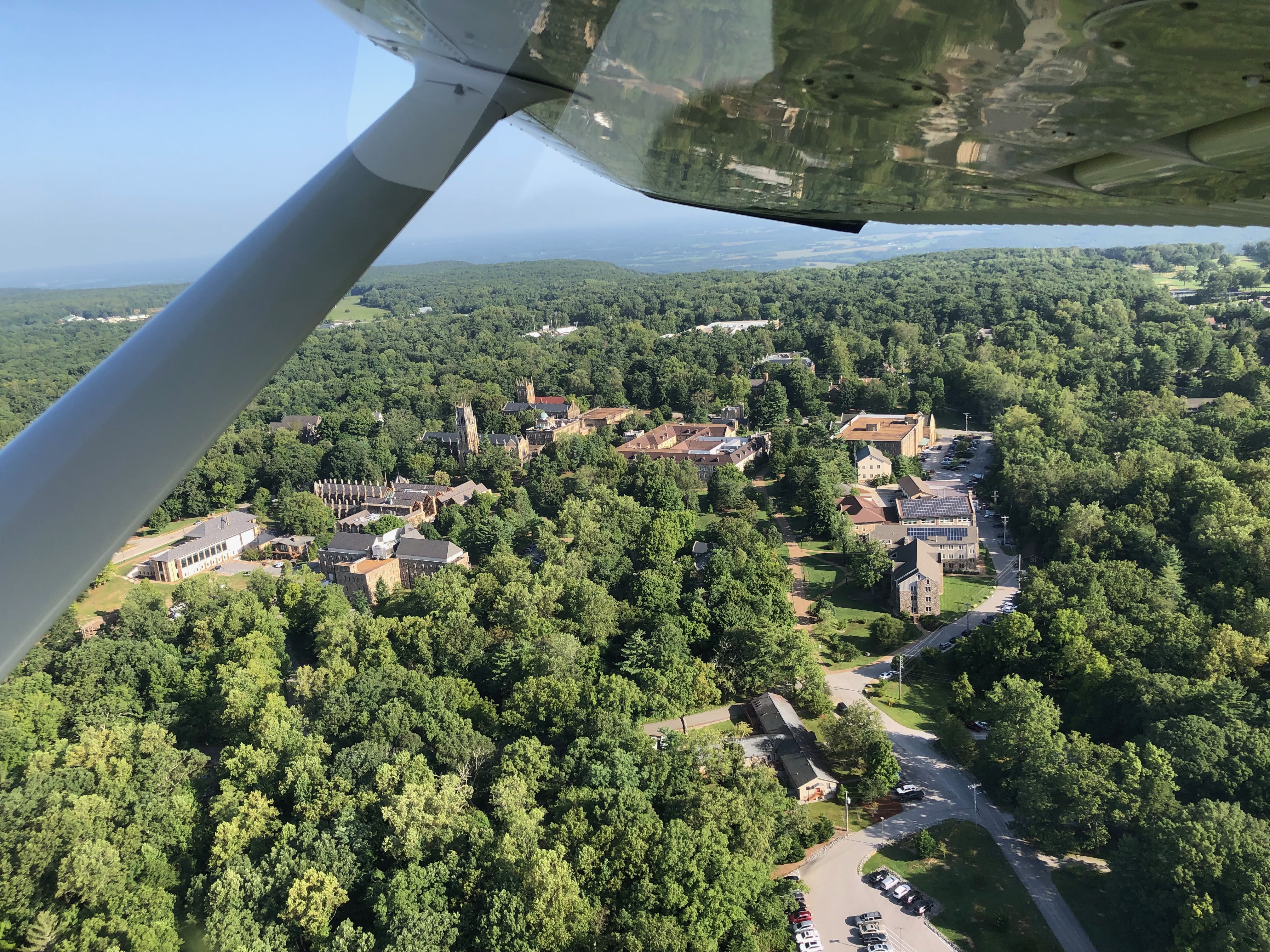
For the past several months, Catherine Cavagnaro, Sewanee professor of mathematics, aviation columnist for Pilot Magazine, aerobatic flight instructor, and former world record holder for consecutive number of spins in an airplane, has taken on a new gig: social media coordinator for the Sewanee Flying Tigers. It’s not because Cavagnaro had copious spare time in her schedule to become an Instagrammer, but because she is passionate about building a program around flight at Sewanee. “I’m working this really hard,” she says during a flight on a glorious sunny afternoon in early March.
An Instagram post from earlier that same day, in fact, captures exactly what she hopes the future of the Sewanee Flying Tigers program will bring. The photo is of a man wearing headphones and sitting at the controls of a sparkling Cessna 172 Skyhawk, with a striking Garmin G1000 digital display. He has just finished his “checkride,” an in-flight test with a certified instructor. In the background, just off the edge of the tarmac, a younger man is sitting on a chunk of Warren Point sandstone, waiting and reading.
For Cavagnaro, this photo represents a future when that sparkling new Skyhawk is busy all day—one student steps out, another takes their place. Ben Merrill lives nearby, comes to Sewanee for flight lessons, and is nearing completion of a course of training. Spencer Doerr, C’24, is a student who has completed his private pilot’s certificate and will qualify as a certified pilot instructor by the fall of 2022.
One engine for that bright future is the plane itself, which the University acquired as 2021 became 2022. The plane is so new that it is just now due for its first washing, and it is a state-of-the-art piece of dynamic equilibrium. The Cessna 172 is the workhorse of flight schools around the world, and Sewanee’s new Skyhawk is equipped with sophisticated instrumentation that will allow students to move up successive levels of certification beyond the private pilot license. “Until just a few years ago, a candidate for the commercial and flight instructor certificates would have to have trained in an airplane with retractable landing gear and controllable pitch propeller,” explains Cavagnaro. “Now this experience requirement may be substituted with time in a technically advanced aircraft, such as our 172, with its G1000 advanced avionics and an autopilot.” Along with the plane came a simulator, installed firmly on the ground, for students to practice maneuvers and fly when the weather is inclement.
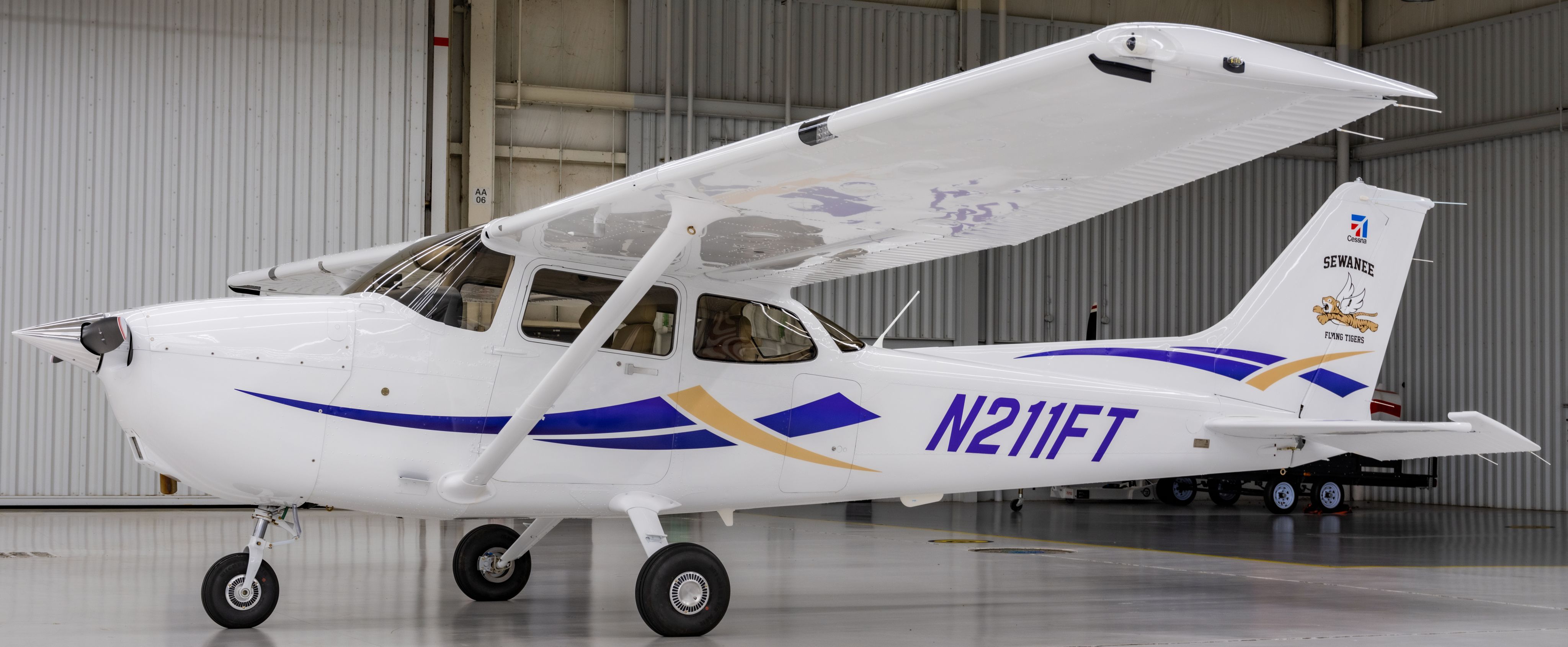
Sewanee's new Cessna 172 Skyhawk will allow students to work toward commercial and flight instructor certificates.
Sewanee's new Cessna 172 Skyhawk will allow students to work toward commercial and flight instructor certificates.
Another key component is the human capital, and Cavagnaro has insisted that Sewanee hire really great flight instructors—not just people going through the motions but who are really qualified and prepared to work with students both from the college and the community. Tommy Johnson, who is now airport manager and the principal flight instructor, is that person. “I gave Tommy his checkride, and I knew he was what we needed,” Cavagnaro says. “That’s what I want: quality instructors, a quality plane, and then just getting the word out about what we have here.” As a columnist for Aircraft Owners & Pilots Association’s Pilot Magazine, Cavagnaro is a well-known name in aviation, and for years has been including Sewanee references in her technical articles. That is a good start on telling the Sewanee Flying Tigers story.
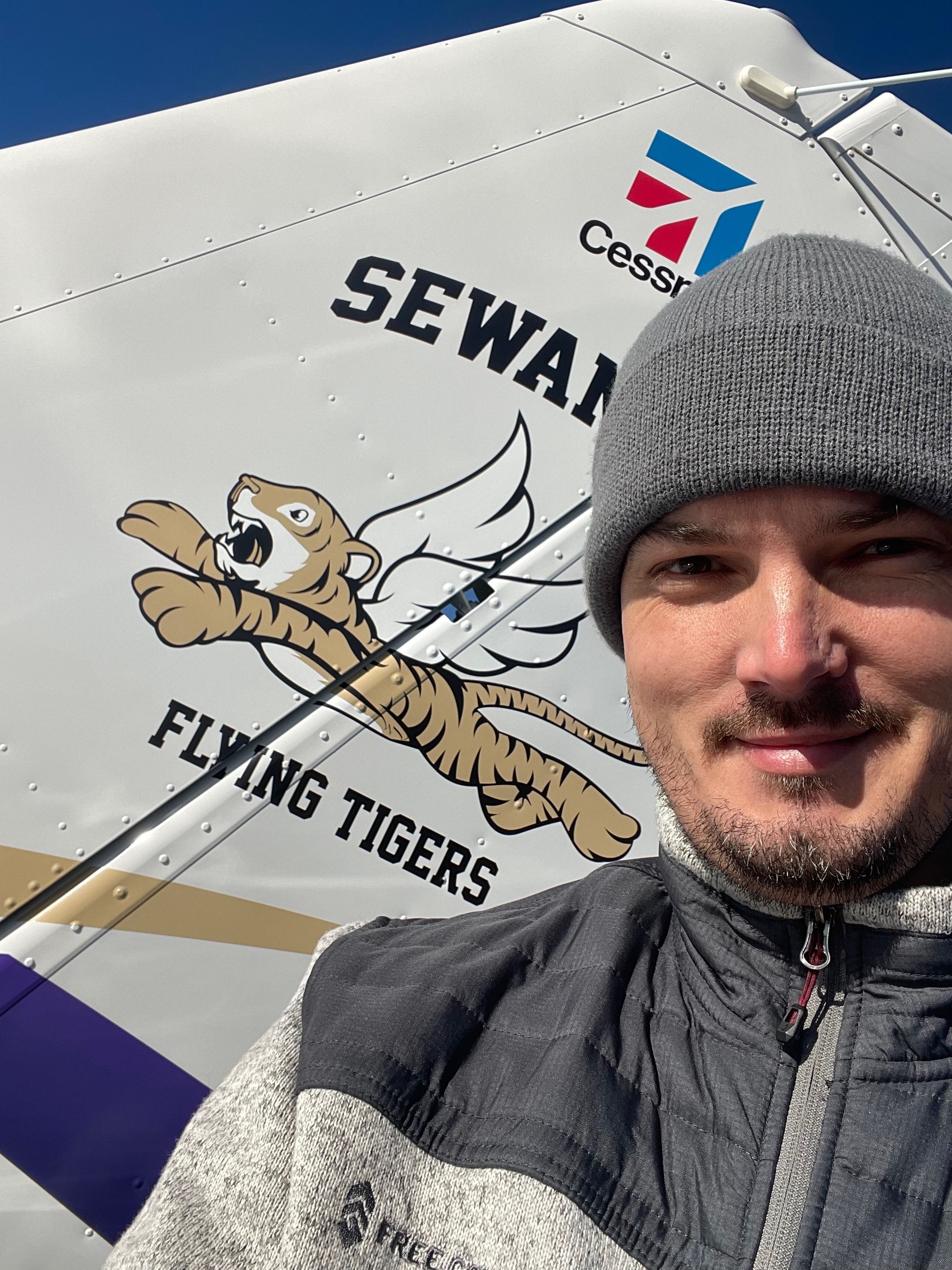
Airport manager and principal flight instructor Tommy Johnson
Airport manager and principal flight instructor Tommy Johnson
“I’ve been thinking about improvements to the flight school for a long time,” says Cavagnaro, as she checks the oil and fuel level in preparation for our flight. “When Reuben [Brigety] was named vice-chancellor, I wrote to him to offer to fly him around campus.” She was delighted when the new vice-chancellor wrote back immediately, “How soon can we make that happen?” On the flight, Cavagnaro pitched her vision. “Have the very best equipment and the very best trainers, and students will come. People will want to be associated with what we are doing.” The upfront investment was significant, but Brigety understood the vision. It was an investment in a distinctive feature of the University: an airport on campus. “I’ve done extensive searching online, and I can only find one other liberal arts college that has an airport on campus,” says Cavagnaro. “The vice-chancellor saw that advantage, and we were able to move ahead.”
With that new airplane in the hangar and a flight instructor who fills her with confidence, Cavagnaro is making good on her promises. Prospective students regularly learn about the airport, and she thinks a number of them will commit to Sewanee on the basis of the Sewanee Flying Tigers flight school. “I want to be on every potential student’s visit itinerary,” she says. “I talk with them and with their parents, and there is a lot of excitement.”
Current Sewanee students are also catching on to the new opportunities at the airport. Six students this semester are registered in flight school, taught by Johnson. It is a package of basic instruction, work on the simulator, and five hours of in-flight training. “That’s a pretty good number,” says Cavagnaro. “We could accommodate eight students per semester, so hitting six in our first semester with the new plane is good.” Students earn PE credit when they take the course.
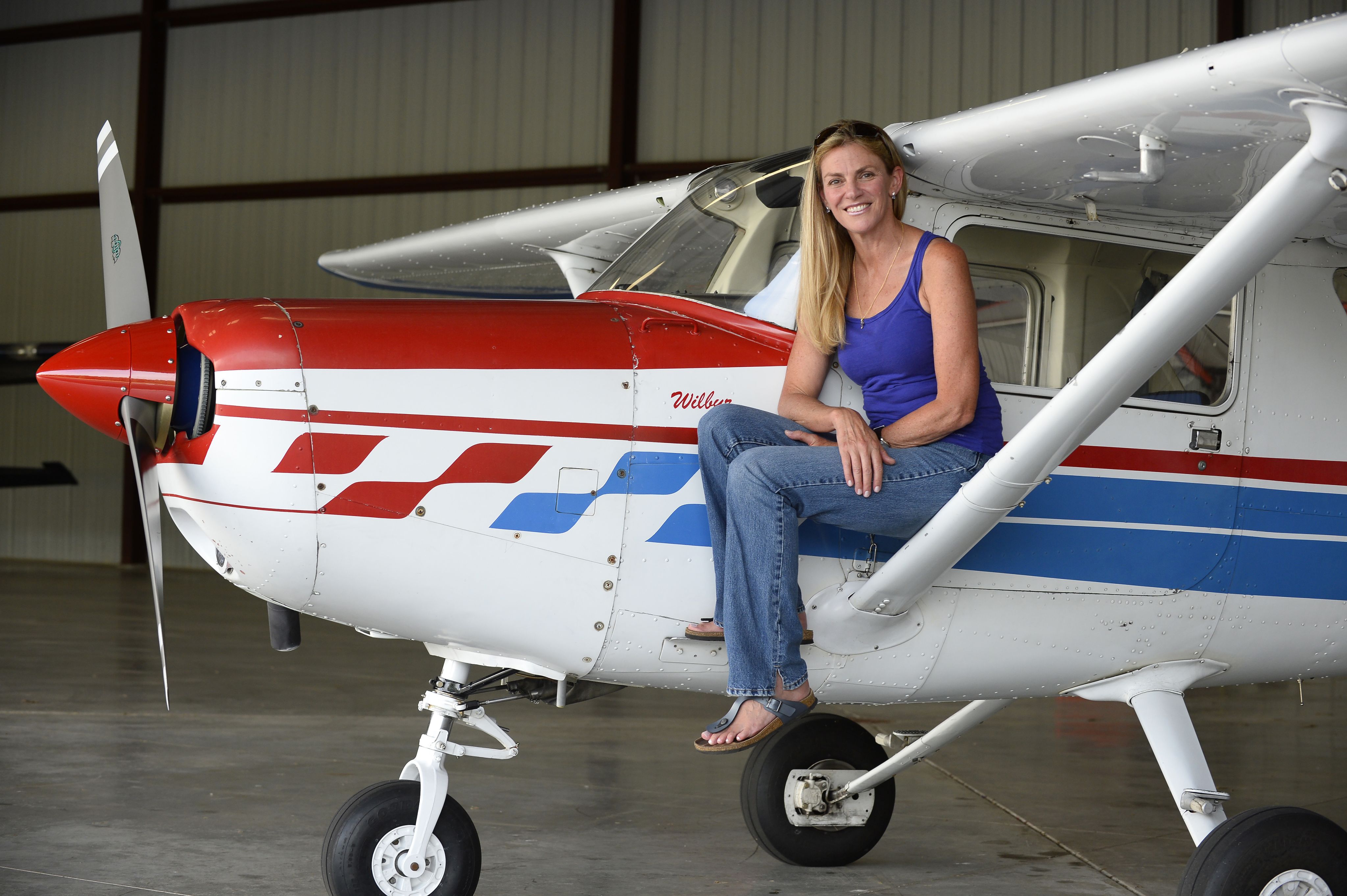
Sewanee Math Professor Catherine Cavagnaro is an aerobatic flight instructor, a columnist for Pilot Magazine, and the driving force behind the Sewanee Flying Tigers
Sewanee Math Professor Catherine Cavagnaro is an aerobatic flight instructor, a columnist for Pilot Magazine, and the driving force behind the Sewanee Flying Tigers
Landing the Liberal Arts
On the day of the post, the Sewanee Flying Tigers class is having its mid-term examination, an oral exam at the airport, accompanied by a generous amount of freshly baked pizza. Some of the students are headed directly toward the private pilot’s license. Taylor Josey, C’23, hopes to complete her required flight hours this summer back home in Austin, Texas. Others, like Caroline Gurek, C’22, are motivated by a desire to round out a Sewanee experience. “All the tour guides talk about how you can get your pilot’s license at our airport,” says Gurek. “When I came for a campus visit, my dad heard that, and he was super excited. Now I am a second-semester senior, so I need to do this before I graduate.”
Nearly 20 years ago, Bethany Davis, C’07, came for her campus tour but already knew about the airport. In fact, she stepped out of a small plane and into the courtesy vehicle at the Sewanee airport, having piloted herself to the traditional pre-college campus visit. Davis came from a family of aviators, and had been around flight her whole life. An airport on campus seemed like an important asset. Davis, who is head of flight deck & connectivity at an aviation startup, was previously one of the youngest program leaders at Gulfstream Aerospace.
Davis credits a liberal arts education for much of her success. “A liberal arts education provides students the opportunity to see the world from various perspectives, and aviation is another lens through which to see the world, another perspective,” she says. “It’s very global in nature, connecting cultures. Art, geography, history, science, language are all in aviation.” She thinks learning to fly is especially important for non-technical majors because they learn that they have the capacity to learn technical information. At the flight school, Johnson’s mid-term examination covers material including thrust and lift, Newton’s third law of motion, fluid mechanics, and Bernoulli’s principle.
“For me personally, having both a liberal arts background, a strong aviation upbringing, and then a technical graduate degree has been invaluable,” says Davis. “I can float between highly technical and very non-technical yet deep, thought-provoking, and logical conversations, building an argument with a thesis just like I did in my papers at Sewanee.”
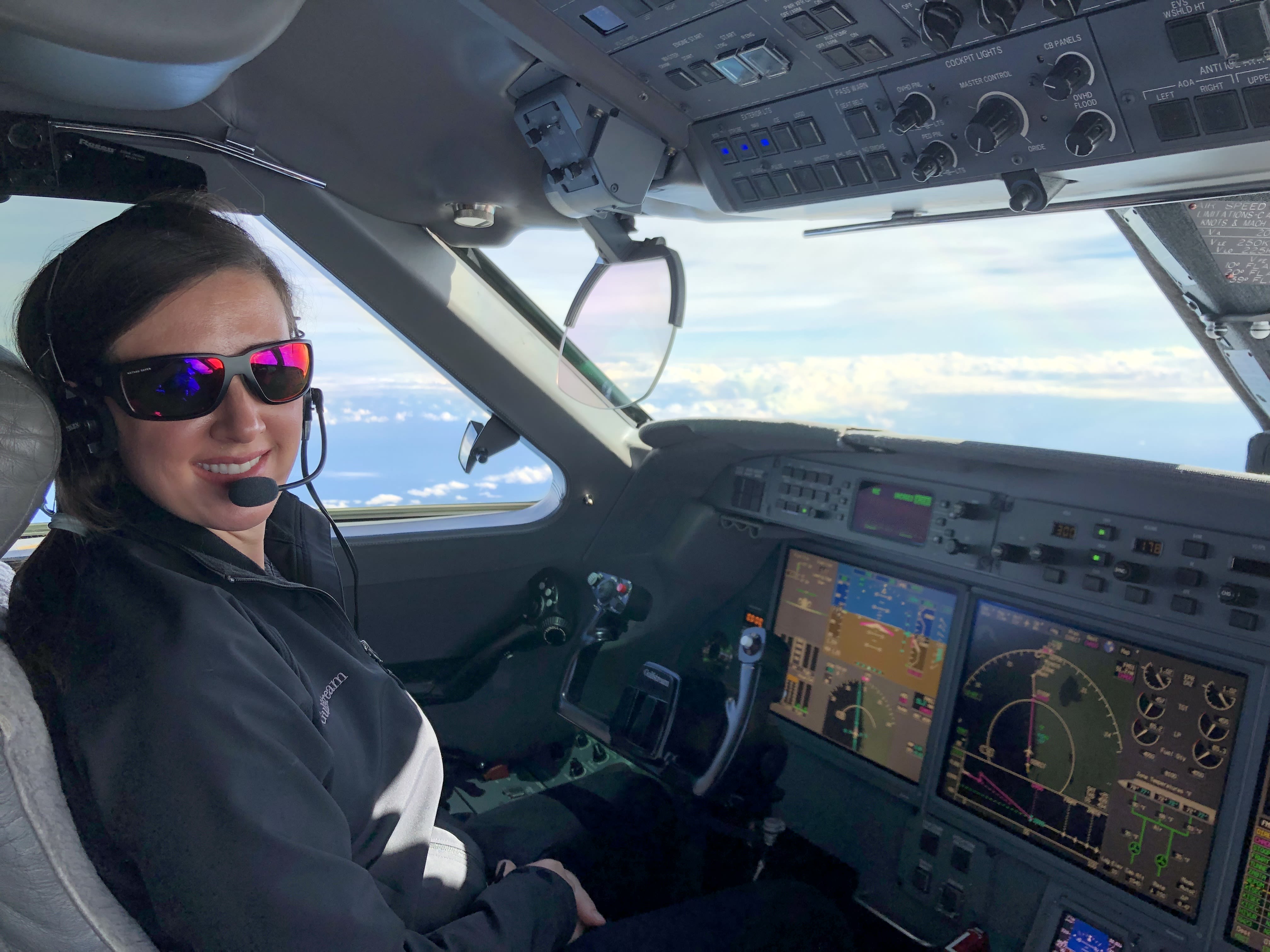
Bethany Davis, C'07
Bethany Davis, C'07
In Flight
Cavagnaro’s offer of a flight around campus on a sunny day is impossible to turn down, and after a thorough pre-flight check and sequence, N211FT takes off on runway 24. During class, the students had been grilled on the Skyhawk’s Vx—its ideal speed for takeoff—and wheels lift off, almost unnoticeably, as the plane’s airspeed hits the perfect number. In flight, Cavagnaro talks about Davis. “One of the things we are really trying to recapture is excitement about flight school when people like Bethany were flying here.” As we make a wide arc around Roark’s Cove she asks if I have met Spencer Doerr. “He’s so enthusiastic, and he’s the current version of Bethany Davis,” she says. “He has been with us from the beginning of thinking about the revitalized flight school.”
While we took off on runway 24, we landed on runway 6. Both runways occupy the same physical space; the runway number refers to the direction of travel. Both runways are 50 feet across, which is quite narrow, a feature that Johnson and Cavagnaro have previously mentioned as an asset in what they call a “gem of an airport.” “It’s narrow, but I think I am going to be able to hit it,” Cavagnaro says slyly as we descend. The landing is as smooth as the takeoff, with no noticeable bump but only the squawk of a tire as the rubber catches the tarmac. “Well, so far, I’m batting 1.000,” she says with a smile.
As the plane approaches the fuel tank, Spencer Doerr makes a beaming appearance. As we greet each other, Cavagnaro shares a photo of herself with Spencer and his mother. “I met Spencer and his mom really because he’s one of these people who can’t drive past an airport without stopping and looking at it,” she says.
“My family kind of gives me a hard time because we spend so much time looking at airports,” Doerr says. “But I tell them, ‘I’m going to be flying in and out of here; I need to know what is here.”
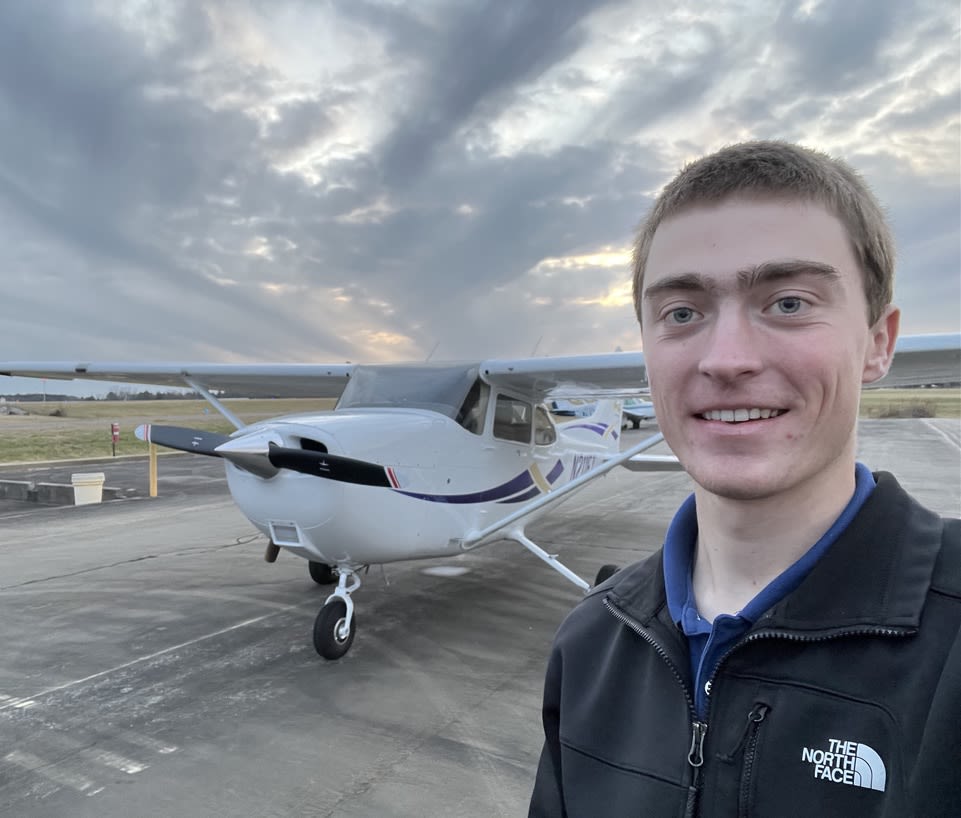
Spencer Doerr, C'24
Spencer Doerr, C'24
“This is a great place to fly because of the location,” he adds. “You are close to so much. An hour or so south and you can be at the beach, and going west, you can be on the plains. I just love it. This is what gets me up every morning. I can’t wait to get to the airport and fly. If it’s foggy, that’s what the simulator is for.” One photo from the Flying Tigers Instagram feed is of the airfield completely snowed in, taken by Doerr at first light because he couldn’t wait to get to the airport.
An international and global studies major, Doerr hopes to fly for the military when he graduates, so he will take all the experience he can get on the Skyhawk. Doerr is also a key to scaling the program up to make the vision of one-person-lands-another-takes-off a reality. In the fall, if all goes well, he will have earned credentials as a certified flight instructor. In this way, Sewanee Flying Tigers is building its own talent pipeline. Cavagnaro and Johnson are recruiting students through admission channels, frequent mentions in a nationally published magazine for aviation, and fruitful in-person introductions. They are giving students great instruction in fundamentals and an opportunity to stretch their wings.
With the new plane in the hangar, 2022 is a kind of checkride for the program. The capital expense is significant (though Cavagnaro notes that the plane is worth more now than when purchased). Prospective new students are excited and applying. It remains to be seen if they will arrive in the fall, but if they do, the vision that new students each year will create a constant flow of energy at Sewanee’s storied airport may just come true.
